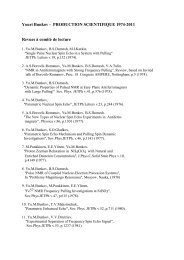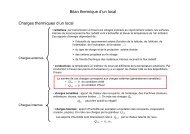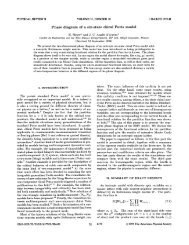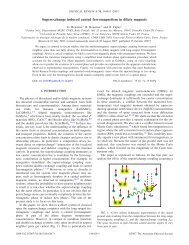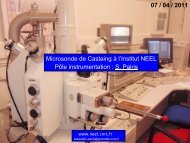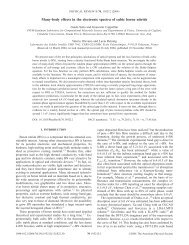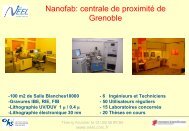Activity Report 2010 - CNRS
Activity Report 2010 - CNRS
Activity Report 2010 - CNRS
Create successful ePaper yourself
Turn your PDF publications into a flip-book with our unique Google optimized e-Paper software.
HIGHLIGHT : NANOMAGNETISM AND SPINTRONICS<br />
CONTACTS<br />
jan.vogel@grenoble.cnrs.fr<br />
gilles.gaudin@cea.fr<br />
laurent.vila@cea.fr<br />
FURTHER READING<br />
V.Uhlir et al., Physical Review B, Rapid<br />
Communications, 83, 020406 (2011)<br />
C. Burrowes et al., Nature Physics, 6, 17<br />
(<strong>2010</strong>).<br />
T.A. Moore et al., Applied Physics Letters,<br />
93, 252604 (2008).<br />
I.M. Miron et al., Nature Materials, 9, 230<br />
(<strong>2010</strong>).<br />
3<br />
DOMAIN WALL<br />
DYNAMICS<br />
IN NANOSTRIPES<br />
Magnetic domain walls in nanostripes<br />
have been proposed to be the basic<br />
element of a new type of fast and cheap<br />
magnetic storage medium. The<br />
displacement of the domain walls in these<br />
nanostripes is induced by current pulses,<br />
through the spin-transfer-torque (STT)<br />
effect. Several Grenoble laboratories<br />
(Institut Néel, INAC/SPINTEC & NM &<br />
LEMMA) work together to obtain groundbreaking<br />
results in this very competitive<br />
field of research, through the fabrication<br />
of innovating materials and the<br />
development and the use of advanced<br />
tools for characterization and modelling.<br />
In 2009, the RTRA project MIDWEST,<br />
yields funds to the 4 laboratories to<br />
develop and share complementary<br />
magnetic imaging techniques allowing a<br />
detailed metrology of domain wall<br />
dynamics in magnetic nanostructures.<br />
Current induced domain wall motion<br />
(CIDM) has mainly been studied in<br />
nanostripes of soft magnetic permalloy<br />
(Ni 80 Fe 20 ) with in-plane magnetization. In<br />
these stripes, relatively high domain wall<br />
velocities were obtained (> 100 m/s), but<br />
the current densities needed were<br />
relatively high (> 10 12 A/m 2 ). These high<br />
current densities are a drawback both for<br />
the power consumption and for the<br />
associated Joule heating of the stripes.<br />
In collaboration with a team from Unité<br />
Mixte de Physique <strong>CNRS</strong>/Thales, the<br />
group of the Institut Néel has used timeresolved<br />
Photo Emission Electron<br />
Microscope (PEEM) magnetic imaging to<br />
investigate CIDM in Co/Cu/NiFe trilayers.<br />
Domain wall velocity up to 600 m/s was<br />
observed in this system, for current<br />
densities that were a factor 2-3 smaller<br />
than required for single permalloy layers.<br />
Images taken during the application of<br />
the current pulses revealed that the NiFe<br />
magnetization, which is parallel to the<br />
axis of the stripes when no current is<br />
applied, tilts in the direction transverse to<br />
the stripes during the current pulses. It<br />
was shown that this is due to the Oersted<br />
magnetic field generated by the current<br />
itself, which is relatively large for these<br />
trilayer systems where most of the<br />
current flows in the Cu and Co layers.<br />
The effect of the Oersted field on the<br />
magnetization of the stripes and the<br />
domain wall may be at the origin of the<br />
high efficiency of CIDM in this system<br />
[Uhlir2011].<br />
Perpendicular magnetized materials are<br />
very attractive for applications since, due<br />
to the simpler and narrower domain<br />
walls, CIDM is predicted to be much more<br />
efficient and the induced displacements<br />
reproducible.<br />
The group of INAC/NM, together with<br />
colleagues from Spintec and IEF Orsay,<br />
has studied domain wall motion in FePt<br />
alloys and Co/Ni multilayers with<br />
perpendicular anisotropy. By studying the<br />
probability of depinning a domain wall<br />
from a natural or artificial defect, as a<br />
function of applied field and current<br />
density, important information was<br />
provided on the STT efficiency, the socalled<br />
non-adiabatic torque. Contrary to<br />
what was expected, the results showed<br />
that this non-adiabatic torque is relatively<br />
insensitive to the domain wall width<br />
[Burrowes2008].<br />
Another system with perpendicular<br />
magnetic anisotropy, consisting of<br />
Pt/Co/AlO x trilayers, was developed by<br />
Spintec, and CIDM was studied in<br />
collaboration with Institut Néel. It shows<br />
a very high CIDM efficiency and, in<br />
contrast to almost all other perpendicular<br />
systems, long distance current-induced<br />
motion of domain walls, essential for<br />
most of the applications, can be observed<br />
in this system, as shown in Fig. 1.<br />
Fig. 1: Differential Kerr images of currentinduced<br />
domain wall motion in 500nm wide<br />
Pt/Co(0.6nm)/AlOx stripes, for two different<br />
current densities (1x10 12 and 1.5x10 12 A/m 2 )<br />
These images were obtained with Kerr<br />
microscopy, using the difference between<br />
images taken before and after the<br />
application of current pulses. For the<br />
lower current densities, the domain wall<br />
velocity increases with current density<br />
following a so-called creep law<br />
[Moore2008], while at higher current<br />
densities a linear increase is observed,<br />
with maximum velocities above 400 m/s.<br />
The Rashba effect due to the structural<br />
inversion asymmetry is thought to be at<br />
the origin of both the high CIDM<br />
efficiency and the high velocities<br />
[Miron<strong>2010</strong>].



